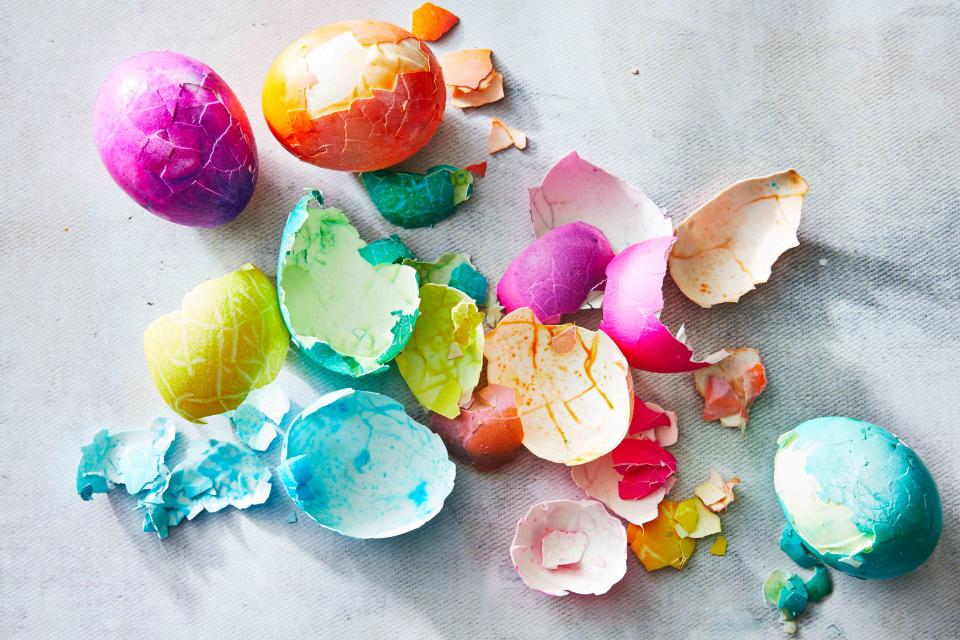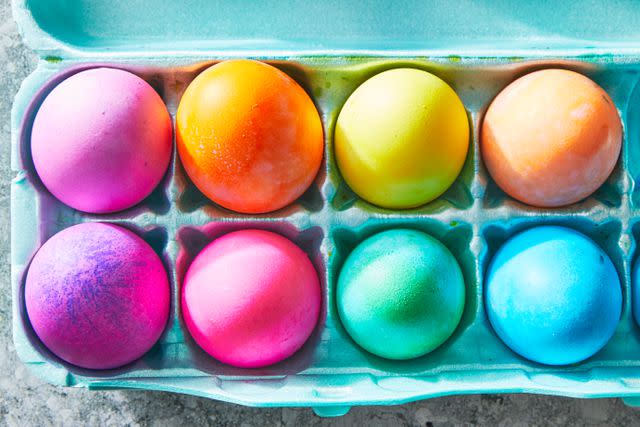12 Creative Ways To Use Those Colorful Easter Eggshells
When the egg hunts are done, don't toss the shells.

Caitlin Bensel; Food Stylist: Torie Cox
There are many ways to use the boiled and dyed eggshells after Easter egg hunts. Instead of wasting shells by simply throwing them in the trash, these more sustainable options allow you to save money and experience fun family activities. You may not be able to eat eggshells, but you still can use them in arts and crafts or in the garden. Read on for more great ideas.
How To Process Dyed Eggshells Before Using Them
Once the egg hunt is over, gather the eggs and peel eggshells away from the boiled egg. It’s perfectly OK if the shells break into tiny pieces; you’ll be using them for mosaic crafts or grinding them into calcium dust for projects. The eggs themselves are not safe to eat.
There are several options to prepare the eggshells for other uses:
To save the shells for crafts, rinse the pieces gently and set them outside in the sun to dry. Separate the pieces by color and store them in a freezer bag or airtight container.
If you’re using the eggshells in your garden, the easiest method is to simply toss the pieces into the soil around the plants.
For a soil supplement, grind the dried shell pieces into a powder in a mortar and pestle, food processor, or simply by hand using a meat mallet or rolling pin over the eggshells in a baggie.
Crafts For Easter Eggshells
For Easter eggshell ideas, we asked first generation urban homesteaders The Busy Homebodies and twins Magadelena and Mary, who "try to make every bit count," what they'd do with leftover eggshells.
As former preschool teachers, they had ideas for using dyed eggshells that kids will love. We added a few additional crafty ideas to help keep them out of landfills:
Eggshell wreath: Create a festive garland or wreath by hot gluing dyed eggshell pieces to yarn or a flat wreath form.
Eggshell mobile: Make a mobile by threading eggshell pieces onto fishing wire and suspending them from a wire hanger with yarn.
Eggshell picture frame: Glue eggshell pieces to a simple frame in a mosaic pattern focused on the colorful dyed eggs. Treat the eggshells like you might make projects with vacation seashells.
Eggshell bottle: Create a dyed-eggshell mosaic with shell fragments by gluing them on to the exterior of clean and dry bottles or small vases.
Eggshell mosaic paintings: Once you’ve collected and dried dyed eggshell fragments, put out construction paper and let kids “paint” with eggshells. Print out examples of simple art like a sailboat, building, or sky; use the drawings or images as a template for them to lay out and glue the eggshells to create their own artwork.
Eggshell chalk: Mix the ground powder from 6 eggshells with 1 tsp. of flour and enough hot water to make a stiff paste (about 1 tsp.). Add food coloring to increase the intensity of the color if desired. Roll into a chalk shape and allow to dry for two or three days before using.
Tip
With eggshell mosaic projects, consider the eggshells’ exteriors. If most of your eggshells are blue and white, a cloud project could work. If you’ve used pastel egg dyes, try creating eggshell flowers.

Caitlin Bensel; Food Styling: Torie Cox
Using Eggshells In The Garden
While making art projects with eggshells is fun, putting them back into the environment also increases your sustainability efforts. If you're considering putting eggshells directly in your soil, first do a quick soil test to check on the existing calcium levels in your soil.
“When you use eggshells in gardening, make sure you break them into small particles for increased surface area and to allow the eggs to break down faster so the nutrients can be better utilized in the soil," says Dr. Teresa Morishita, professor of poultry medicine and food safety at Western University of Health Sciences’ College of Veterinary Medicine.
Tip
Try this eggshell water recipe to add a concentrated nutrient burst to your plant water.
Potting soil: Add calcium-rich eggshell powder or pieces into potting soil before starting seeds or planting.
Compost: Add eggshell pieces into an existing compost pile, or start a new one with the eggshells at the base.
Mulch: Add eggshell powder or pieces to purchased or composted mulch. Crushed eggshells break down more quickly to release calcium and aerate soil, improving water flow.
Garden pests: Eggshells are a natural enemy of garden pests like slugs. Sprinkle eggshell powder or add eggshell pieces into problem areas.
Blossom-end rot: Sprinkle eggshell powder around plants like tomatoes that are prone to or struggling with blossom-end rot. The calcium in the eggshells can help balance soil calcium.
Seed starting: If you're skilled enough to peel your eggs and leave half of the shell intact, you can use the shells for seed starting. Line them up in an egg carton and fill each shell with moist seed-starting mixture. Plant a seed in each shell, water, and set in a sunny window. After your seedling has emerged, you can transplant the shell right into a larger container or the garden, where the shell will eventually break down and fertilize the soil. Crack the bottom first so the roots can escape through the shell.
Is It Safe To Eat Easter Eggs?
According to the U.S. Food & Drug Administration, fully cooking eggs eliminates potentially harmful bacteria like Salmonella. However, boiled eggs shouldn't be eaten if they've been out of the refrigerator for more than two hours or if they've been used in an egg hunt. The shells can pick up bacteria and viruses that penetrate the edible part of the egg.
"Practicing sustainable living means it's a good idea for eggshells to be used after Easter egg hunts, but I suggest they be put into gardens or composting to prevent potential harm like the transmission of disease agents," says Dr. Morishita.
For more Southern Living news, make sure to sign up for our newsletter!
Read the original article on Southern Living.

